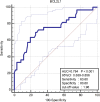The clinical application value of the biomarkers based on autophagy screening in the diagnosis and monitoring of inflammatory bowel disease in pediatric patients
- PMID: 40488902
- PMCID: PMC12149258
- DOI: 10.1007/s00431-025-06213-6
The clinical application value of the biomarkers based on autophagy screening in the diagnosis and monitoring of inflammatory bowel disease in pediatric patients
Abstract
Inflammatory bowel diseases (IBD) are immune-mediated disorders of children and adults. Autophagy dysfunction has been linked to IBD pathology, and we screened and evaluated the potential biomarkers for pediatric IBD diagnosis and activity evaluation. The autophagy gene expression matrix of IBD samples was obtained via GeneCards and GEO databases. Significant differentially expressed genes were obtained using the R language "limma" package, followed by KEGG enrichment analysis using the "clusterProfile" package. Totally, 95 pediatric IBD patients and 44 controls were selected from Beijing Children's Hospital, with IBD subjects divided into the IBD-Remission and IBD-Activity groups. Peripheral blood autophagy-related gene levels in pediatric IBD patients were determined by RT-qPCR. Autophagy genes that were independently correlated with pediatric IBD occurrence and activity were screened, with their value for diagnosing and monitoring the activity of pediatric IBD assessed. OPTN, GABARAPL2, FKBP8, BNIP3L, and BCL2L1 were obtained as the autophagy-related genes. FKBP8 and BCL2L1 mRNA expression levels were elevated in IBD patients. BCL2L1 was an independent risk factor (IRF) for pediatric IBD occurrence. Peripheral blood BCL2L1 > 0.75 had high auxiliary diagnostic value for pediatric IBD occurrence. BCL2L1 and GABARAPL2 were higher in the IBD-Activity group than in the IBD-Remission group. Peripheral blood BCL2L1 was an IRF for pediatric IBD activity. Peripheral blood BCL2L1 > 1.96 had high auxiliary predictive value for pediatric IBD activity.
Conclusion: BCL2L1 was an IRF for the occurrence and disease activity of pediatric IBD and had high clinical application value in assisting pediatric IBD diagnosis and predicting disease activity.
What is known: • Autophagy dysfunction is associated with IBD. • No research reports on the clinical application of autophagy-related biomarkers in the diagnosis and activity monitoring of IBD.
What is new: • BCL2L1 was an IRF for the occurrence and disease activity of pediatric IBD. • BCL2L1 had high clinical application value in assisting pediatric IBD diagnosis and predicting disease activity.
Keywords: Activity; Autophagy; BCL2L1; Biomarkers; Children; FKBP8; GABARAPL2; Inflammatory bowel disease.
© 2025. The Author(s).
Conflict of interest statement
Declarations. Competing of Interest: The authors declare no competing interests.
Figures







Similar articles
-
[Characteristics and clinical significance of neutrophil extracellular traps in children with inflammatory bowel disease].Zhonghua Er Ke Za Zhi. 2025 Jul 2;63(7):759-764. doi: 10.3760/cma.j.cn112140-20241217-00922. Zhonghua Er Ke Za Zhi. 2025. PMID: 40518155 Chinese.
-
Patient education interventions for the management of inflammatory bowel disease.Cochrane Database Syst Rev. 2023 May 4;5(5):CD013854. doi: 10.1002/14651858.CD013854.pub2. Cochrane Database Syst Rev. 2023. PMID: 37172140 Free PMC article.
-
Signs and symptoms to determine if a patient presenting in primary care or hospital outpatient settings has COVID-19.Cochrane Database Syst Rev. 2022 May 20;5(5):CD013665. doi: 10.1002/14651858.CD013665.pub3. Cochrane Database Syst Rev. 2022. PMID: 35593186 Free PMC article.
-
Vitamin D for the treatment of inflammatory bowel disease.Cochrane Database Syst Rev. 2023 Oct 2;10(10):CD011806. doi: 10.1002/14651858.CD011806.pub2. Cochrane Database Syst Rev. 2023. PMID: 37781953 Free PMC article.
-
Intestinal biomarkers, microbiota composition, and genetic predisposition to inflammatory bowel disease as predictors of Parkinson's disease manifestation.J Parkinsons Dis. 2025 Jun;15(4):766-779. doi: 10.1177/1877718X251328567. Epub 2025 May 7. J Parkinsons Dis. 2025. PMID: 40336252
References
-
- Fabian O, Kamaradova K (2022) Morphology of inflammatory bowel diseases (IBD). Cesk Patol 58:27–37 - PubMed
-
- Luo H, Cao G, Luo C, Tan D, Vong CT, Xu Y et al (2022) Emerging pharmacotherapy for inflammatory bowel diseases. Pharmacol Res 178:106146 - PubMed
-
- Yu YR, Rodriguez JR (2017) Clinical presentation of Crohn’s, ulcerative colitis, and indeterminate colitis: symptoms, extraintestinal manifestations, and disease phenotypes. Semin Pediatr Surg 26:349–355 - PubMed
MeSH terms
Substances
Grants and funding
LinkOut - more resources
Full Text Sources
Research Materials

